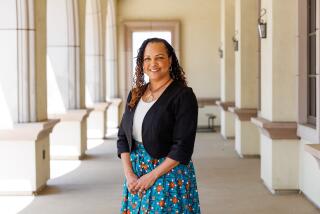Children at Mental Hospital Take Classes--and Find Learning Heals
- Share via
Normal day at the Ingleside Hospital School in Rosemead. Drab basement room with green chalk boards, movable desks and, on the front wall, a black-and-white photograph of Mount St. Helens, volcanic smoke billowing upward.
A blond girl grapples gamely with square roots (“I’ve been at this for three days,” she grumbles), three other girls reduce fractions and a boy works morosely on word problems. They are all patients at Ingleside Hospital, a 146-bed, nonprofit, acute-care psychiatric hospital.
Omer Tilford, principal of the school and teacher of the high school math class, gives the boy an appraising look. “How many problems did you do last night?” he asks.
“One,” says the boy, pushing his homework to the front of his desk.
Tilford winces. “You need more time? I’d hate to work you to death.”
The boy’s eyes remain averted.
“How’d you like to have your hair cut off like me?” growls Tilford, a muscular man with a bald, bullet-shaped dome who is commonly referred to by students as “Boss.”
The boy gravely considers a reply.
“Watch out what you say,” Tilford hastily warns. “If you say ‘no,’ you’re saying you don’t like my hair. If you say ‘yes,’ I might bring in my scissors.”
The boy grins at Tilford’s whimsical threat and digs into his assignment.
According to hospital administrators, Tilford and other special education teachers at this ambitious school, which offers four hours a day of schooling for troubled youngsters age 6 to 18, have turned a state requirement--that children hospitalized for long periods of time receive instruction--from a stopgap measure into a boon.
While some hospitals provide perfunctory tutoring, the Ingleside school aims to give students a fresh view of school.
“The school operates from the basic premise that, rather than cramming as much information into kids’ heads as possible, you should give them some pleasure in learning,” says Richard Atkins, director of the adolescent program, which has a shifting clientele of about 40.
That means allowing youngsters to work at their own pace, emphasizing successes rather than failures and clearing the air of the atmosphere of recrimination that troubled youngsters so often experience in school. “What you need is a confidence pill,” Tilford tells the girl who is floundering with square roots. (By the end of the class, she has mastered the discipline.)
Tilford, who has been working at the school for 22 years, practices a kind of jujitsu instruction. He comes at the students obliquely, challenging them, throwing them off balance, then gently setting them down, their defenses breached but their self-esteem intact.
“They learn basic things here--to listen, to communicate,” says Tilford.
The difference is apparent to the students. “Here you can ask questions,” said a 16-year-old girl with cascading brown hair. “In my regular school, if you asked them to explain something one more time, you got yelled at, so you were afraid to ask.”
Mix of Ages, Levels
Operating out of a suite of basement classrooms in the hospital complex on East Hellman Avenue, the school has something of the odd mix of ages and achievement levels of the old single-room country schoolhouse. “You might have second-graders doing simple addition next to eighth-graders working on pre-algebra problems,” says Paul Fusco, who teaches grammar school and junior high school students.
Nowadays, most adolescent psychiatric hospital programs operate schools, says Dr. James Skalicky, a therapist at Sierra Royale Hospital in Glendora who did his dissertation on hospital schools. “It’s a diagnostic tool. In a classroom, the teacher can see things like a kid’s frustration tolerance, his problem-solving skills, his self-esteem level.”
One difference at Ingleside is that the hospital works closely with public school systems. All of the teachers are employed by local school districts--the Alhambra School District for high school and the Garvey Unified School District for lower grades.
176 Students
Teachers grapple with the special challenge of working for short terms with their students. Last year, 176 students came through, staying an average of 28 days. Many struggle with learning disabilities. Many have acute family problems that have led them to drugs or suicidal episodes.
But teachers contend that the results of Ingleside’s stress-free environment can be, like the blow-up on Tilford’s classroom wall, volcanic. So different is it from most public schools that, after years of pent-up curiosity or ambition, students can make sudden, explosive commitments to learning.
Take Laura (not her real name), an 18-year-old who was going nowhere fast when she signed herself into the hospital last March. She went from near drop-out status to high school graduation at Ingleside, where she earned 45 credits in less than three months.
“They really get you motivated here,” says Laura, who gave a stirring valedictory address at a graduation ceremony at the hospital last month. “They tell you, ‘Hey, you can do this.’ ”
Hated School
School had usually been an imposition for Laura, who is blond and thin, with the light-footed grace of a fencer. “I was just never at school,” she says. “I hated it. I had better things to do with my time.”
Such as?
“Drugs. I’d go to my friend’s house and do drugs all day long.”
Laura was an enigma to both of her parents, who live in different states. “My dad would say, ‘Oh, I can’t handle you,’ and, boom, he sent me to my mom,” she says. “Then my mom would say, ‘I can’t deal with you,’ and send me back to my dad.”
By the time she got to Ingleside, Laura had convinced herself that the high school diploma that most of her classmates were homing in on was as remote for her as travel to the moon.
Stack of Books
“But just having people around me who cared--that made the difference,” she says. “They said, ‘You’re going to graduate, Laura. We’re going to help you.’ ”
Teachers gave her a stack of workbooks and a pile of texts and challenged her to finish, step by step, her graduation requirements. So far, 94 high school students and 81 junior high school students have earned diplomas while at the 22-year-old hospital school.
“The only competition here is with yourself,” says Tilford. “You know, for example, that if you finish such and such a book, you earn five credits.”
The treatment approach for adolescents at Ingleside involves a system of rewarding positive behavior and withholding privileges for poor behavior. While Tilford and his staff of two teachers and five teacher aides proffer the pleasures of schooling, psychiatric staff work their patients into the reward structure, often providing the kindly guidance that parents never did.
“The biggest mistake most parents make is that they have a real difficult time setting limits for their kids,” says occupational therapist Monica La Barbera. “They don’t want to be the bad guys, until something happens. Then when they start pulling in the reins, kids don’t respond. You have to establish firm, consistent limits.”
Most of the parents of adolescent patients were young in the 1960s, adds Atkins. “With that mentality of pushing aside tradition, a lot of the 1960s parents don’t adequately appreciate how to structure their children’s lives,” he says.
That can mean making life too easy for their children. “The parents of one kid, contrary to all of our recommendations, delivered a brand-new Porsche to the hospital on his 16th birthday,” Atkins said.
Treatment staff try to get the youngsters working toward specific goals, using the prod of reward and punishment.
“Parents often think they have no leverage,” Atkins added. “Things like driving privileges, allowances, curfews--parents give them away free. They feel totally helpless.”
Part of the success of the school is that the teachers aren’t the enforcers, Tilford says. Teachers don’t hammer their students with threats. Working with small groups, they have time to provide individual attention and get emotionally involved with students.
“Teachers are usually really afraid of being human,” contends Tilford. “The other day a kid told me he was depressed. I said, ‘Great. At least you know what you’re feeling.’ Life is up and down. If it starts to look like this”--he draws a straight line in the air, like an image on the screen of a heart monitor--”then you’re dead.”
After more than two decades at the school, Tilford always has ex-students popping out at him unexpectedly. He went to Redondo Beach one day last year. “I saw this figure coming at me, with his arms out,” Tilford recalls. “I thought he was going to attack me. Then he said, ‘Mr. Tilford, thanks for teaching me how to read.’ ”
End of Tilford’s math class. A chunky girl in a T-shirt, who has already announced that she’ll be discharged later that day, remains in her seat. “Can I stay a little longer?” she pleads. “I’m not going to be here after today, and I want to stay as long as I can.”
More to Read
Sign up for Essential California
The most important California stories and recommendations in your inbox every morning.
You may occasionally receive promotional content from the Los Angeles Times.













